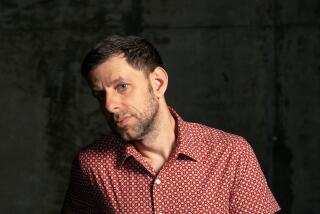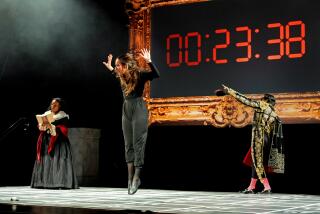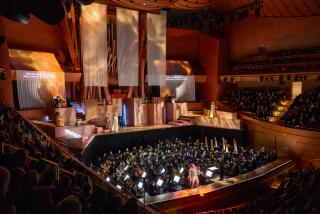The Literate Listener’s Guide to Wagner’s ‘Ring’
- Share via
When KCET (Channel 28) and KUSC (91.5 FM) simultaneously broadcast Richard Wagner’s “The Ring of the Nibelung” this week, starting with “Das Rheingold” on Monday, June 18 at 8 p.m., and continuing nightly through Thursday with “Die Walkure,” “Siegfried” and “Gotterdammerung,” several things will not happen. A major toy manufacturer will not produce Ring action figures with plastic moveable arms and detachable shields and spears. A national fast-food chain will not offer free French fries to anyone who scratches off the silver plasticine on a Lotto-style ticket to reveal three matching Rhine maidens. A store will not open in an Orange County mall called “Ring World,” which sells T-shirts featuring a Conan clone approaching a flame-encircled Fraulein (body by Frazetta), thinking to himself, “Das ist kein Mann!”
Winning new converts (the only adequate term) and boring others, Wagner’s epic musical drama (opera seems too small a word) will be watched and heard by many millions of Americans, convincing both its adherents and its detractors of the rightness of their respective positions. No matter how you feel about Wagner (genius, egomaniac, excessive, profound, revolutionary, and vapid all come to mind) and the “Ring,” it’s hard to imagine our world and its multitude of popular cultural icons--Star Warriors, Super- and Bat-men, Hobbits--without Wagner. Unfamiliarity with Wagner constitutes an ignorance of, well, Wagnerian proportions.
If you’ve never seen or heard the “Ring” before, this Metropolitan Opera production affords the perfect opportunity. And if you wish an introduction to the intricacies of Ringiana, there is probably none better than M. Owen Lee’s “Wagner’s Ring: Turning the Sky Round,” sub-subtitled “Commentaries on the Ring of the Nibelung.” Its most obvious virtue is its brevity: In fewer than 100 pages, Lee sets the philosophical, political and historical scene, reviews the plot, comments on the action by incorporating Wagner’s own words into Lee’s and others’ analyses, suggests further reading, and even reviews some of the discography. I cannot contain the temptation to dub Lee’s book the “new, faster-format” Ring commentary, though there are many precedents to this approach.
Like John Culshaw’s famous “Reflections on Wagner’s Ring,” Lee’s book sprang from his intermission remarks broadcast during the Metropolitan/Texaco “Ring” of last year, the very production we await this coming week. Lee, a Catholic priest, is also a professor of classics at the University of Toronto, and has taught courses in comparative literature, art, music and film. The scope and breadth of his knowledge and the passion he feels for the music make his introduction more illuminating than the commonly reprinted commentaries found in opera house programs. My only objection to his book is the spare choice of music examples, and the omission of some of the critical motifs.
One hundred pages can barely scratch the surface of a work that Edward W. Said, in his excellent review of this “Ring” in the June 18 edition of “The Nation,” calls “still almost impossible to comprehend, so untidily does (it) sprawl across nearly every aspect of the culture of the modern West.” Of the many important studies of the “Ring,” George Bernard Shaw’s “The Perfect Wagnerite” is perhaps the most entertaining. It is no mere coincidence that both author and subject enjoy adjectival status, e.g., Shavian wit and Wagnerian dimensions (but never Shavian dimensions and Wagnerian wit). Shaw, no slouch in the ego department himself, found the “Ring” to be a moral parable and a political allegory, replete with economic ramifications and Marxist dialectics, agreeably compatible with Shaw’s own brand of Fabian socialism, though Shaw characteristically took Wagner to task for not writing the sort of opera he should have written in “Gotterdammerung.”
A very different approach can be found in Robert Donington’s “Wagner’s ‘Ring’ and Its Symbols.” Donington interprets the symbols of the work--the wood bird, the dragons, the ash tree--as Jungian archetypes and the narrative as a hero’s journey a la Joseph Campbell. The fun of such interpretation lies not so much in its veracity--one can accept or reject it--but in the way it illuminates all the components of the work. Be forewarned: Donington presumes his readers can read music.
There is an almost inexhaustible supply of Wagnerian commentary for those whose appetites are merely whetted by Lee, Shaw or Donington. Deryck Cooke’s “I Saw the World End: A Study of Wagner’s Ring” is the most complete interpretation that uses the music as its starting point (though Cooke died before completing it). I especially enjoy the recent Dover reprint of the music criticism of Eduard Hanslick, who died in 1904, and who sat at the first performances of many of Wagner’s operas (as well as Brahms’ symphonies, Strauss’ tone poems, etc.). In a world that seemed divided into Brahms and Wagner camps, Hanslick, though tending toward the former, was able to set the Wagnerian genius (which he readily admitted) in the context of his own times. (On his first experience of the “Ring” in Bayreuth, Hanslick writes: “The ‘Ring’ is, in fact, something entirely new, something essentially different from all that has gone on before, a thing alone and apart.”)
The text of the “Ring” is available in a dual-language edition with the English translation by The New Yorker music critic Andrew Porter. Though this version is, as Porter writes, one to be sung and acted, not read (which may excuse its somewhat stilted diction), it is an indispensable accompaniment.
If you find yourself really bitten by the “Ring” bug, however, and needing to be committed--I mean, needing to make a commitment, the redoubtable Dover Reprints has reprinted the entire “Ring” cycle in their original B. Schott Sohne full orchestra scores on good paper with sewn signatures. For those up to it, there are few more satisfying experiences than following in full score an opera of this magnitude under the baton of a conductor like James Levine. There are also few more frustrating experiences than losing your place. As an added dividend, all four scores boast Arthur Rackham illustrations on their covers.
But will it stop with the music and the books? Perhaps not. Somewhere between Madison Avenue and the Marina, a vision may yet take place. In the beginning was the Hula-Hoop. Subsequent decades saw Beatlemania, OM, and then Greed. At last, as the sages and prophets foretold, we see the dawning of the pre-millennial ‘90s, the Age of Wagner Merchandising. Nubile teen-age mutant water nymphs. Skinhead godsheads cavorting with talking birds. A full third of Mr. Jenkins’ second-grade class comes to the Halloween festival dressed as Valkyries. Digital watches chime the hour in half-diminished seventh chords. “Valhalla!” opens in a drained Florida wetland. Tune in Monday.
WAGNER’S RING Turning the Sky Round by M. Owen Lee (Summit Books: $16.95)
THE RING OF THE NIBELUNG by Richard Wagner A new translation by Andrew Porter (W. W. Norton: $9.95, paper)
HANSLICK’S MUSIC CRITICISMS by Eduard Hanslick (Dover: $6.95, paper)
THE PERFECT WAGNERITE by George Bernard Shaw (Dover: $3.95, paper)
WAGNER’S “RING” AND ITS SYMBOLS The Music and the Myth by Robert Donington (Faber & Faber: $8.95)
I SAW THE WORLD END A Study of Wagner’s Ring by Deryck Cooke (Oxford: $14.95, paper)
DAS RHEINGOLD by Richard Wagner (Dover: $12.95, paper)
DIE WALKURE by Richard Wagner (Dover: $19.95, paper)
SIEGFRIED by Richard Wagner (Dover: $15.95, paper)
GOTTERDAMMERUNG by Richard Wagner (Dover: $21.95, paper)
More to Read
The biggest entertainment stories
Get our big stories about Hollywood, film, television, music, arts, culture and more right in your inbox as soon as they publish.
You may occasionally receive promotional content from the Los Angeles Times.










